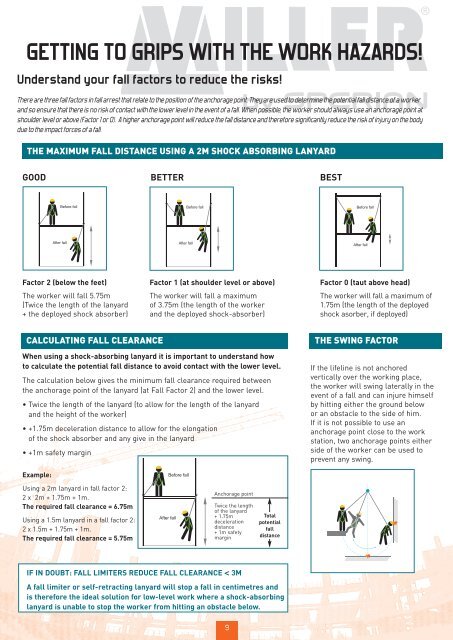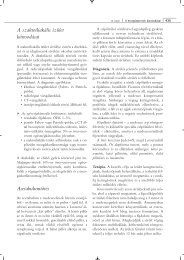FALL Protection 2007
FALL Protection 2007
FALL Protection 2007
- No tags were found...
Create successful ePaper yourself
Turn your PDF publications into a flip-book with our unique Google optimized e-Paper software.
GETTING TO GRIPS WITH THE WORK HAZARDS!Understand your fall factors to reduce the risks!There are three fall factors in fall arrest that relate to the position of the anchorage point. They are used to determine the potential fall distance of a workerand so ensure that there is no risk of contact with the lower level in the event of a fall. When possible, the worker should always use an anchorage point atshoulder level or above (Factor 1 or 0). A higher anchorage point will reduce the fall distance and therefore significantly reduce the risk of injury on the bodydue to the impact forces of a fall.THE MAXIMUM <strong>FALL</strong> DISTANCE USING A 2M SHOCK ABSORBING LANYARDGOOD BETTER BESTBefore fallBefore fallBefore fallAfter fallAfter fallAfter fallFactor 2 (below the feet)The worker will fall 5.75m(Twice the length of the lanyard+ the deployed shock absorber)Factor 1 (at shoulder level or above)The worker will fall a maximumof 3.75m (the length of the workerand the deployed shock-absorber)Factor 0 (taut above head)The worker will fall a maximum of1.75m (the length of the deployedshock asorber, if deployed)CALCULATING <strong>FALL</strong> CLEARANCEWhen using a shock-absorbing lanyard it is important to understand howto calculate the potential fall distance to avoid contact with the lower level.The calculation below gives the minimum fall clearance required betweenthe anchorage point of the lanyard (at Fall Factor 2) and the lower level.• Twice the length of the lanyard (to allow for the length of the lanyardand the height of the worker)• +1.75m deceleration distance to allow for the elongationof the shock absorber and any give in the lanyard• +1m safety marginTHE SWING FACTORIf the lifeline is not anchoredvertically over the working place,the worker will swing laterally in theevent of a fall and can injure himselfby hitting either the ground belowor an obstacle to the side of him.If it is not possible to use ananchorage point close to the workstation, two anchorage points eitherside of the worker can be used toprevent any swing.Example:Before fallUsing a 2m lanyard in fall factor 2:2 x 2m + 1.75m + 1m.The required fall clearance = 6.75mUsing a 1.5m lanyard in a fall factor 2:2 x 1.5m + 1.75m + 1m.The required fall clearance = 5.75mAfter fallAnchorage pointTwice the lengthof the lanyard+ 1.75mdecelerationdistance+ 1m safetymarginTotalpotentialfalldistanceIF IN DOUBT: <strong>FALL</strong> LIMITERS REDUCE <strong>FALL</strong> CLEARANCE < 3MA fall limiter or self-retracting lanyard will stop a fall in centimetres andis therefore the ideal solution for low-level work where a shock-absorbinglanyard is unable to stop the worker from hitting an obstacle below.9












